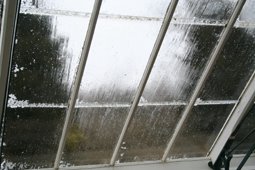 Very wet, very cold and very windy weather last week = Very tidy greenhouse.
Very wet, very cold and very windy weather last week = Very tidy greenhouse.Also, no more mealy bug on our citrus trees. Tony spent a morning wiping the leaves our oranges and lemons free of mealy bugs, in the warmth of the greenhouse . These little creatures look nothing more than a tiny speck of cotton wool stuck to the branches or leaves of the oranges, and colonies will increase if not treated.
 Low numbers will not really cause any harm to plants, but severe infestations can lead to eventual death of the plant.
Low numbers will not really cause any harm to plants, but severe infestations can lead to eventual death of the plant.Because of the waxy 'cotton wool' covering these pests have, pesticides have a limited effect, so physically removing them with a little soapy water is far more effective.
And at least you escape the worst of the wet, cold and wind.
















